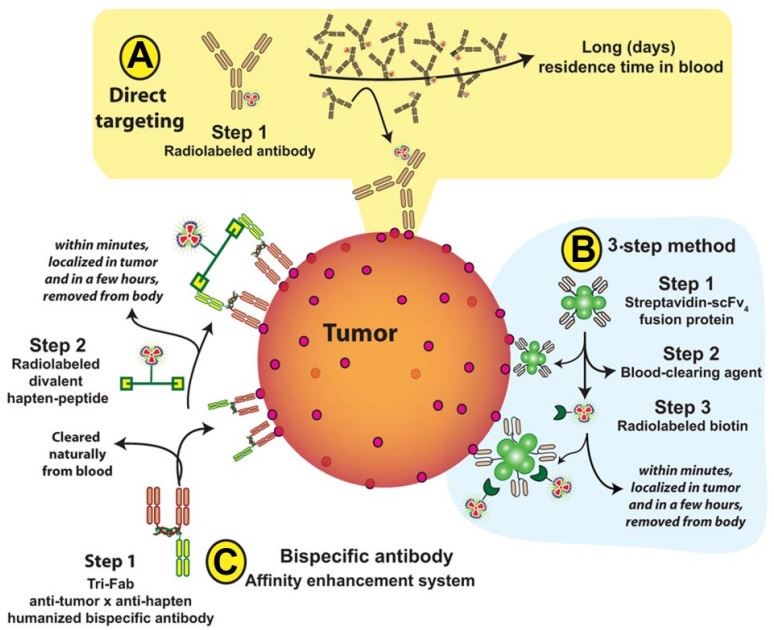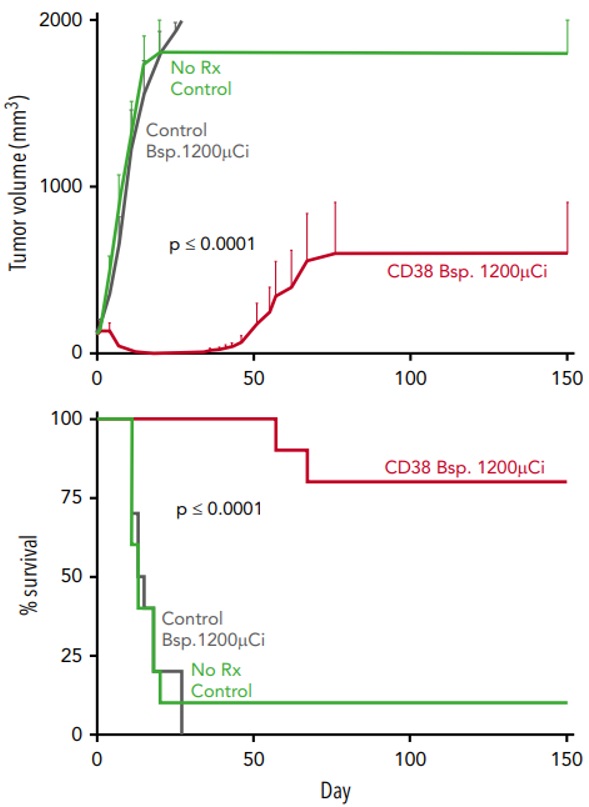Backgrounds Applications Advantages Published Data Our Services
Creative Biolabs has substantial work experience in the design and manufacture of payload-delivered bispecific antibody (BsAb) products with empirically proven high affinity. We are confident in offering best-in-class BsAbs to fulfill your immunoradiotherapy program development needs thanks to the efforts of Creative Biolabs' experienced professionals.
Introduction to Radioimmunotherapy
Radioimmunotherapy is a type of targeted cancer therapy in which radiolabeled antibodies are utilized to deliver deadly radiation to tumor cells. A basic targeting approach involves delivering radioactivity to tumor cells by antibodies that target antigens expressed by tumor cells. Pretargeting approaches separate the administration of the antibody from the subsequent delivery of the radionuclide, reducing the radionuclide's residence time in the blood, which is the primary source of dose-limiting hematologic toxicity. In animal model systems, including solid and hematologic cancers, pretargeting methods exhibit decreased hematologic toxicity and greater efficacy.

Fig.1 The primary modalities of radioimmunotherapy.1
Applications of BsAbs in Radioimmunotherapy
Research started with the development of a BsAb made from two Fab fragments, one against TAA and one against DTPA loaded with indium, which was later shown to be effective in pretargeting xenograft tumor models by increasing the radiation dose absorbed by the tumor. An anti-CD20-bispecific fusion protein constructed by an anti-CD20 antibody and an anti-chelated radiometal trap for a radiolabeled ligand (yttrium [Y]-DOTA) captured by a very high-affinity anti-Y-DOTA scFv antibody. The CD20 BsAb showed efficacy in the treatment of subjects with Ramos or Granta subcutaneous lymphoma, with a significant reduction in myelosuppression. In animal models, all animals that received optimal doses of the CD20 BsAb were cured after 150 days, whereas tumor growth in control animals progressed rapidly and became a complete disease after 25 days². Among the reported BsAbs used for radioimmunotherapy, commonly used TAA targets include CEA, CD38, GD2, HER2, PSMA, mesothelin, hK2, etc., and hapten-peptides including HSG, DFO, etc. In addition, a variety of antibody formats have been developed, including IgG, Fab-Fab, Tri-Fab, scFv-scFv, etc.
Advantages
Using a BsAb as the primary targeting agent is a promising pretargeting strategy that has substantially improved the therapeutic efficacy and reduced the toxicities of radioimmunotherapy. BsAbs employ a novel radiolabeled hapten-peptide system that may be tailored to bind a wide range of therapeutic and imaging radionuclides. Furthermore, fully humanized BsAbs can be created, which are significantly less immunogenic than an antibody conjugate or recombinant protein including streptavidin or avidin. Another potential advantage of the BsAb technique is that it does not require an additional step to remove or block the primary targeting antibody prior to the addition of the radiolabeled peptide.
Published Data
|
Paper Title
|
CD38-bispecific antibody pretargeted radioimmunotherapy for multiple myeloma and other B-cell malignancies
|
|
Journal
|
Blood
|
|
Published
|
2018
|
|
Abstract
|
An anti-CD38-bispecific fusion protein was created by the researchers, that eliminated endogenous biotin interference and an immunogenic component, and they provided a new PRIT method for treating multiple myeloma (MM) and other B-cell malignancies. An innovative CD38-bispecific construct demonstrates excellent blood clearance rates and excellent tumor targeting in mice xenograft models of MM and non-Hodgkin lymphoma (NHL). The CD38-bispecific PRIT resulted in 100% full remissions in MM and NHL xenograft models in 12 days, eventually curing 80% of mice when supplied at optimum dosages. In direct comparisons, the efficacy of the CD38 bispecific is equal to or better than that of the streptavidin (SA)-biotin-based CD38-SA PRIT. CD38 PRIT may benefit individuals with resistant, high-risk illnesses because refractory disease frequently retains radiation sensitivity. It is established that PRIT may not only extend but even cure MM and treatment-refractory NHL patients.
|
|
Result
|
Researchers identify a novel CD38-bispecific targeting protein for MM and NHL PRIT. The BsAb is exceedingly simple to make, has great blood clearance utilizing a low-cost CA, and has excellent tumor-to-normal organ ratios of absorbed activity, as evidenced by favorable dosimetry in murine models. Furthermore, in two xenograft models, the CD38 bispecific greatly reduces disease burden and subsequently cures 75% to 80% of mice at optimum dosages. Although CD38-SA is equally efficient at the maximum radiation dosage, the bispecific's superiority over a range of doses, as well as its lower risk of immunogenicity and lack of endogenous biotin interference, makes the CD38 bispecific a perfect choice for clinical translation.

Fig.2 The influence of CD38-bispecific PRIT on tumor growth and survival in mice of H929 (MM) xenografts.3
|
Our Services
As a global company, Creative Biolabs is delighted to display our advanced integrated engineering platform, which ensures cost-effective and time-saving BsAb services for all clients. Our experienced and well-trained experts are here to assist you in your research.
References
1. Goldenberg, David M. "Some like it hot: lymphoma radioimmunotherapy." Blood, The Journal of the American Society of Hematology 113.20 (2009): 4823-4824.
2. Green, Damian J., et al. "Comparative analysis of bispecific antibody and streptavidin-targeted radioimmunotherapy for B-cell cancers." Cancer research 76.22 (2016): 6669-6679.
3. Green, Damian J., et al. "CD38-bispecific antibody pretargeted radioimmunotherapy for multiple myeloma and other B-cell malignancies." Blood, The Journal of the American Society of Hematology 131.6 (2018): 611-620.
Our products and services are for research use only, and not for use in diagnostic or therapeutic procedures.
Welcome! For price inquiries, we will get back to you as soon as possible.
To order, please email
INQUIRY










